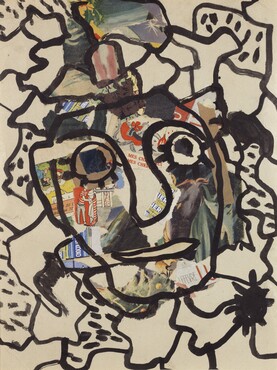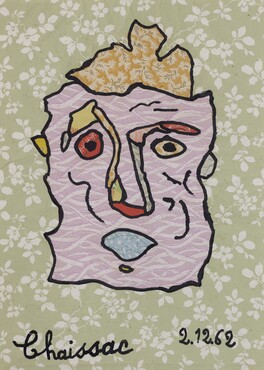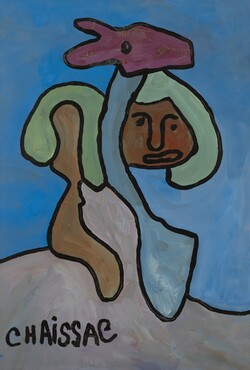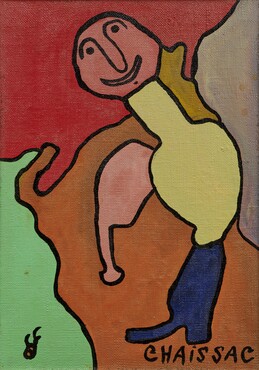Ontdek de collectie
Kunstmuseum Den Haag has a treasure chamber of over 160.000 pieces of art. Here we work on making the highlights from this collection available online.
CoBrA and Chaissac
In 1961 Gaston Chaissac (1910-1964) exhibited work at Iris Clert’s renowned Paris gallery. It was enthusiastically received by all. The CoBrA artists (no longer a group by then) were the most excited by the works on show, and indeed they fought over them. The entire exhibition sold out in no time. Unfortunately, Chaissac was unable to attend for health reasons, and he would never meet his admirers in person. But they had inspired each other for years by then, as Kunstmuseum Den Haag will demonstrate for the first time in its exhibition CoBrA and Chaissac – Kindred Spirits.
Animatie: Ruben Van Esterik - Voice-over: Yousef Gnaoui - Muziek: Arjen Jongeneel
Self-taught artist Gaston Chaissac lived a reclusive life far from the cultural metropolis of Paris. Yet his expressive drawings, paintings and sculptures, with their vibrant colours and black contours, did not go unnoticed. Though he never joined any art movement, the similarity between his work and that of the CoBrA artists is obvious. This movement grew out of the post-war zeitgeist, as artists broke with older tradition in pursuit of a new modern art for all, in which spontaneity, authenticity and honesty were paramount. A shared interest in naïve art and folk art, and the use of motifs like snakes and totems, made them kindred spirits. They painted everything they could get their hands on.
Gaston Chaissac
-
Things may have turned out completely differently if Gaston Chaissac had not met painter Otto Freundlich and his wife Jeanne Kosnick-Kloss in Paris, where he lived with his brother for a time, running a shoe repair business. Freundlich, already a well-known artist, recognised Chaissac’s talent and gave him some painting materials. Chaissac, who was trying to make a living for himself as a craftsman, blossomed as he finally dared to devote himself to his art. In 1938 the couple arranged his first exhibition at Galerie Gerbo in Paris.
Chaissac’s work evolved during the 1950s and 60s, a period when a wide variety of movements existed in parallel. His work fulfilled the huge desire in the art world and among the public for unspoilt forms of expression after the Second World War. Chaissac’s art attracted a great deal of attention, particularly from other artists. As such, he became a true artists’ artist. He managed to combine the ludic with the tragic, was cheery, colourful and authentic, but at the same time also deeply melancholy, solitary and lonely. This is why he was regarded as such an important artist in a decade where French existentialism dominated philosophy. His work could not be pigeonholed into any movement, however (Chaissac was explicitly against this!) and the variety of media and techniques he used made him idiosyncratic and unique.
-
In Paris, he visited museums and galleries, and got to know more about architecture. He would later recall: “What fascinated me most was depictions of nature painted in colours that do not occur in nature, and it was precisely those colours that made them so beautiful”. He was not interested in openings and salons, preferring to stay at a distance, following his wife Camille, a teacher whose work took the couple to remote places like Boulogne-en-Vendée, Sainte-Florence-de-l’Oie and Vix. There, he was free to work on his ‘peinture rustique et moderne’ (rustic modern painting), as he described his work, and to develop his art as he saw fit. He also worked with schoolchildren and craftsmen to create ‘art for all’.
Despite his reclusive life in the countryside, Chaissac did maintain a lively correspondence with critics, journalists, writers, painters and magazine editors. This kept him informed of, and part of, the artistic debate. In 1946 he came to the attention of Jean Dubuffet, who saw him as a representative of his Art Brut concept. But Chaissac did not wish to be labelled, and he distanced himself from the designation. He also had indirect contact with the members of CoBrA via magazines and galleries in Paris, and there was a great mutual admiration between them.
Though the artists of the CoBrA group returned regularly to their countries of origin, and had exhibitions in Amsterdam, Brussels and Copenhagen, Paris remained the place where they met and showed their work. Paris was also an important point of reference for Chaissac’s ideas about art, and for his exhibitions. In France, Gaston Chaissac is still regarded as an important modern artist,and major museums regularly stage retrospectives of his work. Kunstmuseum Den Haag will introduce this artist to the Netherlands, combining his work with that of CoBrA for the first time. Chaissac and CoBrA will be shown in separate galleries (though with plenty of glimpses through to the other), mirroring the situation in real life, their works rarely having occupied the same space at that time. Nevertheless, the visual dialogue presented in the exhibition and the accompanying catalogue will clearly reveal their kinship in a way never seen before.
CoBrA and Chaissac – Kindred Spirits has been created in collaboration with guest curator Angelika Affentranger-Kirchrath.
After its run in The Hague the exhibition will move on to Musée Soulages Rodez, where it is due to open in December 2021.
Publication
Waanders & De Kunst will publish the exhibition catalogue CoBrA en Chaissac – Zielsverwanten (in Dutch only) designed by Harald Slaterus, and including articles by Angelika Affentranger-Kirchrath, Vanessa Noizet, Nadia Raison-Chaissac (Chaissac’s granddaughter), Gaëlle Rageot-Deshayes.
Price € 27.50.
CoBrA and Chaissac – Kindred Spirits is sponsored by Kickstart Cultuurfonds.





